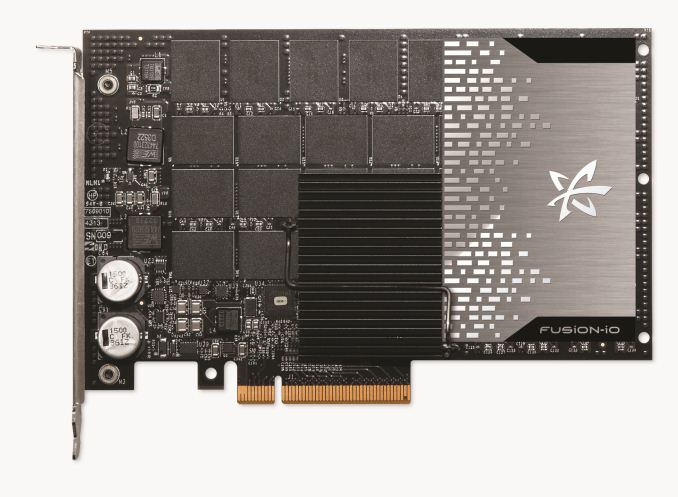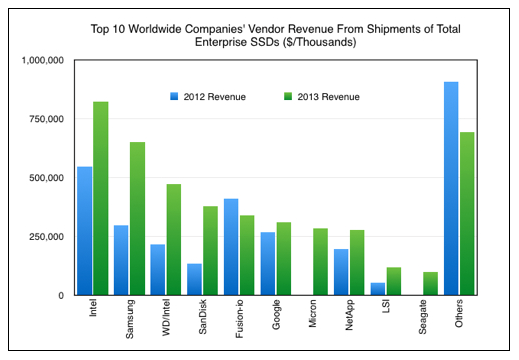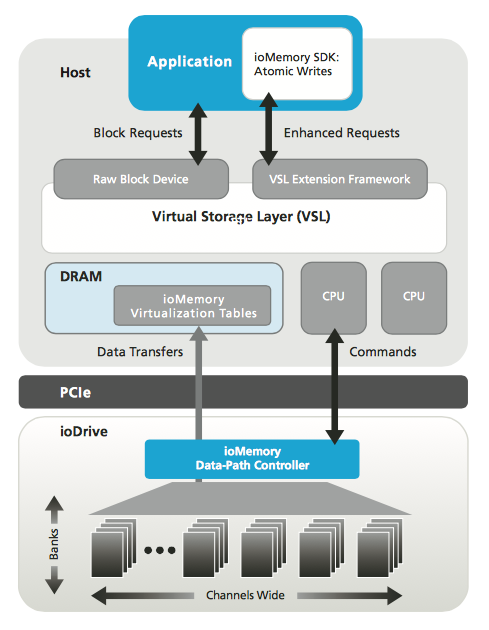The State of SanDisk
by Kristian Vättö on December 5, 2014 8:00 AM ESTThe Enterprise
In mid-July SanDisk announced their acquisition of Fusion-io and the acquisition was completed a couple of week prior to Flash Memory Summit. I posted my initial thoughts when the news hit the public, but I feel that it's worth doing a bit deeper analysis now that I have given it some more thought and discussed it with John Scaramuzzo, senior vice president and general manager of SanDisk's enterprise business.
SanDisk has managed to establish itself as one of the key players in the enterprise SSD space over the past few years. The acquisitions of Pliant in 2011 and SMART Storage Systems in 2013 provided SanDisk with strong expertise and product lineups for SATA and SAS SSDs but left the company without a solid long-term plan for PCIe. I heard Pliant's initial roadmap included plans for PCIe-based solutions as well, but it looks like those plans never materialized.
Up until the Fusion-io acquisition, the Lightning PCIe SSA was the only PCIe solution in SanDisk's enterprise product portfolio, and as a matter of fact that drive is internally a SAS-based design with a PCIe to SAS bridge onboard. In other words, SanDisk had practically zero real PCIe solutions for the enterprise, while at the same time SanDisk's biggest competitors, such as Intel and Samsung, have had PCIe drives for a long while already.
Fusion-io's 3.2TB Atomic Series SSD
Fusion-io's strategy and product portfolio, on the other hand, was a complete opposite. From the beginning Fusion-io has focused on PCIe storage, which dates all the way back to 2007 when the company released its first ioDrive that utilized a PCIe x4 interface and was capable of speeds up to 800MB/s. Not only was Fusion-io early in the market, but the company was also able to garner a few massive and very important clients – the most notable being Facebook and Apple. I don't think it's an overstatement to say that Fusion-io can be considered as the pioneer of PCIe storage because it was the first company to turn PCIe SSDs and storage in general into a large, successful business.
But stories eventually come to an end. The competitive advantages Fusion-io had were its PCIe technology and several high-level customers, but the advantages were lost when the NAND manufacturers stepped into the PCIe territory. It's nearly impossible for a company that has to source its NAND from a third party to compete against another company that manufactures NAND in-house since the latter will always have advantages in cost. While Fusion-io didn't lose its customers to competitors overnight, it's clear that especially Intel and Samsung snagged a share of Fusion-io's business in the past couple of years.
In a nutshell, the acquisition brings SanDisk the long-needed expertise in PCIe storage along with Fusion-io's broad PCIe product portfolio. The acquisition is now a bit over 100 days in and the Fusion-io employees have been integrated into SanDisk's existing teams. Initially Fusion-io's engineering team was separate and worked under Lance Smith, the former President and COO of Fusion-io, but Mr. Smith decided to leave SanDisk and pursue other options. Last week a data virtualization startup Primary Data announced that Mr. Smith has joined the company as the new CEO, which explains his quick departure from SanDisk.
All the engineering talent has now been unified and the team is lead by Mr. Scaramuzzo. With everyone under the same roof, the roadmaps are now in the process of being integrated to bring the expertise together. It will be a while before we see the fruits of the acquisition, but in the meantime the latest Fusion-io products will transition to SanDisk NAND for increased cost efficiency.
But what about NVMe? That has been the hot topic in the industry this year and I bet many of you are wondering what is SanDisk's and Fusion-io's play in that field. The short version of their strategy is that Fusion-io already has a technology called Virtual Storage Layers (VSL), which is essentially a driver/software stack similar to NVMe. The truth is that NVMe isn't really anything new from a technology perspective, but what makes it alluring for many manufacturers is the fact that the NVMe drivers are universal and already supported by the latest operating systems. Technologies like VSL are rather expensive to develop and require expertise because there is no framework available (i.e. everything has to be developed from scratch), but on the other hand an in-house driver like VSL allows for more customization and optimization.
However, that doesn't mean that SanDisk has no interest on NVMe whatsoever. The company sees that as the entry and mid-level enterprise SSDs move from SATA and SAS to PCIe, NVMe will be one of the key factors because of easy and quick deployment. For that market segment the NVMe spec and its limitations are fine – it's only the high-end segment where the benefits of VSL are more prominent. It's actually likely that many manufacturers will turn to custom NVMe drivers anyway for higher and more optimized performance, and in fact that is already happening with Intel providing its own NVMe driver for the P3600/P3700.
Lastly, let's quickly discuss the ULLtraDIMM. I wrote a quick piece on ULLtraDIMM right after Flash Memory Summit, but SanDisk has already scored Huawei as the third ULLtraDIMM partner (in addition to IBM and Supermicro). The first generation product that is currently available is internally based on a pair of SATA 6Gbps controllers, but SanDisk said that a native DDR to NAND controller is possible in the future if the market adopts the new form factor well. As usual, the industry is fairly slow in adopting new form factors, so it's hard to say whether NAND DIMMs will really take off, but it's a very interesting and potentially useful technology.
Final Words
All in all, SanDisk is definitely one of the most interesting NAND companies going forward. USB drives, eMMC solutions, SSDs and even the storage arrays from the Fusion-io acquisition are all built on NAND, which puts SanDisk in a unique position as it's the only NAND manufacturer that focuses solely on NAND products. The company can't turn to alternative revenue sources like e.g. Intel and Samsung can, but on the other hand that's also SanDisk's strength as all the know-how and experience in the company is related to NAND in one way or the other.
Ultimately next year will be crucial for SanDisk because it determines whether the company can materialize all the underlying potential from the Fusion-io acquisition and become a serious competitor to Intel and Samsung in the enterprise space. The pieces are definitely there, so it's just a matter of execution now.














132 Comments
View All Comments
designerfx - Friday, December 5, 2014 - link
I concur. Price is still a barrier. SSD's provide a substantial improvement, but they are still a price premium.When 240GB SSD's get to around $50-60, we'll be at price. Until then, we explicitly aren't.
Michael Bay - Saturday, December 6, 2014 - link
This.Somewhere around 50 is the psychological barrier for an impulse buy, too.
moretoys - Friday, December 5, 2014 - link
Capacity and performance and the way operating systems are designed to me is a barrier. Most people want simple, are not techies. IMO most PCs would want performance on key things like OS boot, commonly used apps, but they also want space for long term storage, things more read than written. To use an SSD with a Hard Drive is complex to implement like this, not automated. If small SSDs could be installed and automatically take on the activities needing the performance boost without users needing to manage it, making a small SSD, practical for the masses, then they would have something.Please note I am not talking about likely 80% or more of readers here, who like me can do this themselves, but really, it is a pain.
hojnikb - Friday, December 5, 2014 - link
Windows coult implement this. When it detects an SSD and HDD combo, it should automaticly move programs and other stuff that can benefit from ssd to the actually ssd and movies/music to the HDD (Ie Documents folder to the HDD by default).SilthDraeth - Friday, December 5, 2014 - link
I work for a retail company that does upgrades like this, unfortunately we charge quite a bit unless someone has one of our "support" plans. Which all said and done isn't a bad deal for most of the masses that can't be bothered to figure out how to install a SSD. I think, if OEM started releasing more laptops with SSDs in them without a $300 premium for it, we would see more adoption as well. Seriously the majority of "regular" people PC that I work on have around 30gb of data at max. A few outliers have close to 100 GB. Instead of throwing 1tb HD into all systems, why not use 250gb SSD. Your budget machines will perform better, thus giving people a better experience and less likely to go buy brand B next time. Maybe a kiosk with a budget machine running a 5400 rpm drive, and one running an SSD. With a few easy to demonstrate programs geared to take advantage of the SSD would help.Cloakstar - Friday, December 5, 2014 - link
The way I have convinced people to purchase SSDs, especially in conjunction with a new computer:For people who use the PC for "office"-type work (Web, e-mail, Word, Excel, etc), an SSD is the one component change that will make a significant difference in computer "speed".
-An SSD responds to the computer 2 orders of magnitude (>100x) faster than an HDD, because:
-Other than a fan, the HDD is the last mechanical component in the modern PC.
-SSDs act more like RAM than the HDD.
-So, an SSD:
-Makes the computer feel much faster.
-Prevents the PC from getting slow as quickly
-Makes the computer last longer
-Is the one and only component change that can prevent the kind of slowdown your old PC is giving you. Not a "fast" CPU. Not more RAM. An SSD.
If you don't rip DVD's to your hard drive on a regular basis, a 256GB SSD is big enough, and it will make your computer feel much faster for its entire life, especially as it ages.
PeterMorgan573 - Friday, December 5, 2014 - link
I'm just about willing to opening up the box and install a new SSD, but not if it requires the operating system to be significantly tweaked for it to be used effectively. Given my 3-6 year computer replacement cycle, I'll almost certainly wait for my next computer purchase and include an SSD as well as an nTB hard drive if possible. [Probably needless to say, I've just created this account, I've been following Anand for 3 months only for background, not because I'm ever going to build my own or an enterprise system.]For new computers, a fast SSD could be cheap if its use were optimized just for fast start/restart. Not that that usage helps SSD manufacturers.
earl colby pottinger - Saturday, December 6, 2014 - link
Why do you need to tweak it.Yes, that gets max performance but I already see a huge speed up if I "DD" the hard drive over to the SSD and just plug it in as the boot drive.
All the tweaks can be done at a later time or not at-all and you still see a big speed boost.
Cerb - Sunday, December 7, 2014 - link
The operating systems already are tweaked. For Windows, just do a fresh instal to the fresh SSD. It will handle the rest. All the shenanigans some people go through are entirely unnecessary, and the few good (or bad, if you use the related features being disabed) tweaks are as good for an HDD-based system as an SSD-based one.Cliff34 - Friday, December 5, 2014 - link
Your question about how to for Sandisk to penetrate the consumer market is a hard one. At the end of the day, SSD is a geeky tech that most people do not (or will not) understand or care. For someone who is into IT, they definitely see the need and excited about the fast speed load time and transfer files. But for most consumers, they do not know worry so much about that.Unfortunately, I see this is how the adoption from CD to DVD is like. When DVD first come out, the consumers weren't crazy getting new DVD drives for their computer. They only do so because there's a need (DVD movies). They buy DVD players and not everyone rushing to bring their computer to a store to have it upgrade to a DVD drive.
Given time, price decrease and what not, DVD becomes a standard. I see is the same for SSDs. The driving market for SSDs (consumer end) is still those who are IT savy. For your consumer, like my dad who only use the laptop to read the news and watch youtube video, they don't mind the slow boot time and will not be willing to invest in a SSD. He might as well get a new computer after a few years.
The good news for us, consumers, is that through the years because of competition, the price per GB gone down significantly. But for the manufacturer, they either have to mass produce (low cost) or create very fast drives and sell at a premium to make a profit. Anything else it will be hard for them to survive.